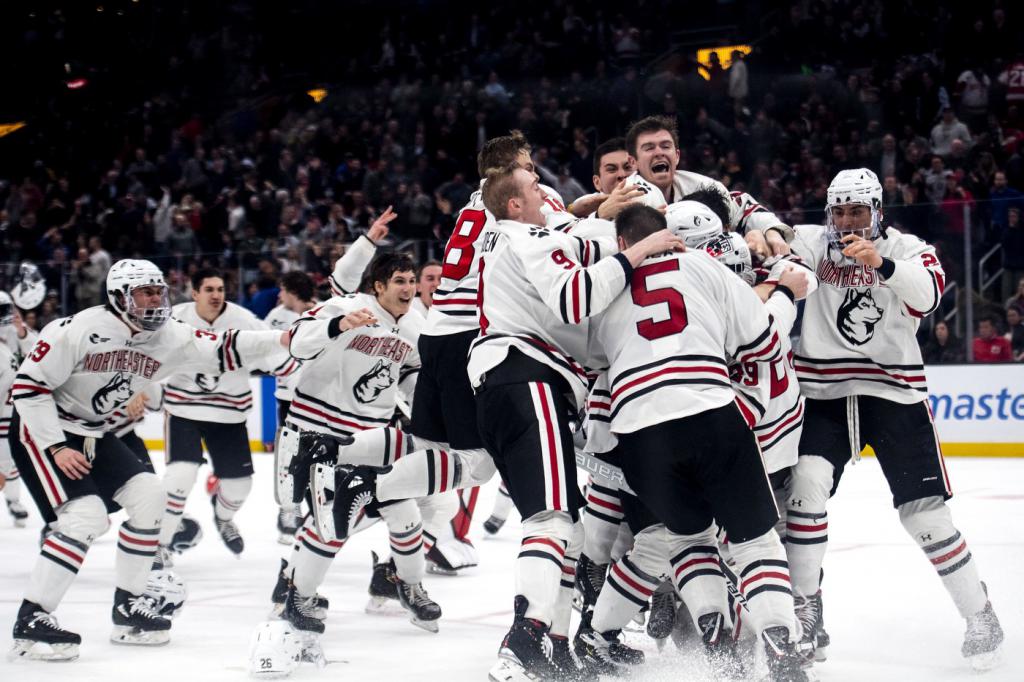Tyler Toffoli's goal-scoring breakthrough was a long time coming

Three weeks into the NHL season and the league goal-scoring leader is exactly who we all expected it to be: Tyler Toffoli. Wait, what?
The Montréal Canadiens winger has made a major impression with his new team, mostly by absolutely torching the Vancouver Canucks, the organization that let him slip away in free agency back in October.
Near-universal praise descended upon Canadiens general manager Marc Bergevin as the ink ran dry on Toffoli's four-year, $17-million contract, but it was most boisterous in the more analytically inclined corners of the hockey world. Through the early proceedings, rightly so, it would seem.
No, I'm not going to tell you that any credible public model predicted Toffoli would score at a 73-goal pace to start the season. In fact, they anticipated quite the opposite. What his statistical profile did reveal was that the Habs could rely on Toffoli to tilt the ice in their favour by generating dangerous scoring chances and making smart complementary plays. That part was predictable.
The signs were there. Toffoli's brief, productive period with the Canucks, who acquired him at last year's deadline, offered a sample; his eight goals in 17 regular and post-season contests prorates to about a 39-goal pace over an 82-game season. It's just that we were occluded from Toffoli's scoring touch by an inability to translate scoring chances into goals and points.
To grasp Toffoli's sudden emergence in Montréal, it's important to recognize the relatively lacklustre finishing that mired him previously, and what's changed for him in La Belle Province.
Tyler Toffoli and the Concept of “Play-Driving”
It's no secret that the analytics community™️ has an affinity for players who "drive play." That is, skaters who contribute positively to their team's share of the scoring chances at 5-on-5. The reason for that is pretty straightforward; if a team out-chances the opposition, this will typically lead to out-scoring the opposition.
That's not always how that goes though. The models we tend to rely upon as analysts to account for scoring chances use "expected goals," a stat based on priors to make informed estimates of the danger of an attempt.
Some players don't have very good or accurate shots, and this tends to reveal itself as they underperform their expected goal outputs. Furthermore, limitations in the data that the NHL makes publicly available often result in certain chances being systematically over or under-valued; for instance, the league's scorekeepers note the type of shot that was taken (wrist shot, slap shot, tip) but not whether it was a one-timer or whether it came off of the rush or whether the goalie was screened. In the vast majority of cases, this stuff evens out over a large enough sample.
There are teams and players at either end of the systems spectrum that produce wonky outputs in these models though. Players with very accurate shots will consistently outperform their individual and on-ice expected goals, as will elite passers who consistently give their teammates open nets to shoot at and teams that play mostly off the rush. On the other hand, teams or players might generate empty-calorie scoring chances, contested shots off of in-zone possession where the goalie can see the puck, isn’t moving, and makes a save with relative ease.
How does this relate to Toffoli? Because for the past few seasons, he’s been a perfect example of a player whose team consistently did not score up to expectations when he was on the ice. Here’s how he has profiled in the past three seasons analytically using my player cards:
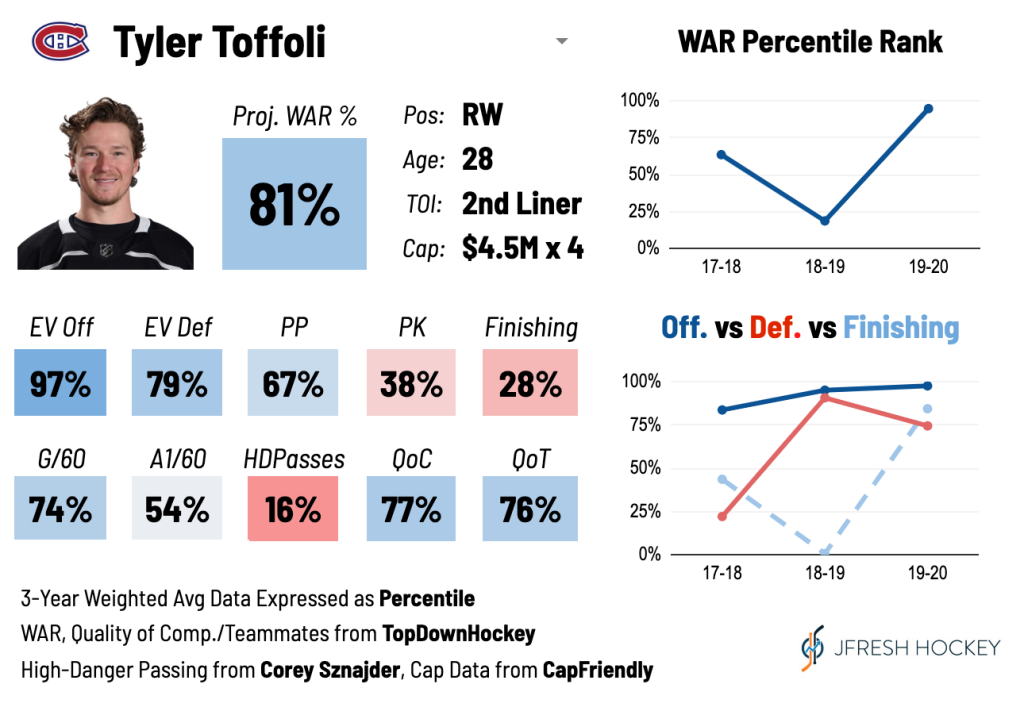
The “EV Off” category above describes his even strength offensive impact on his team’s scoring chances in the past three seasons -- better than 97 percent of other forwards in the league. Those are elite numbers, especially when paired with his strong defensive impact. If they were backed up with goals, Toffoli would be one of the league’s best players. Prior to this season, they hadn’t been, which begs the question: Why?
Read this excerpt from former Leafs and Marlies development coach Jack Han’s assessment of his skill set:
In a game where a large chunk of goals are scored off quick strikes off the rush, Toffoli’s preferred offensive strategy is inefficient: He has the instinct and functional toughness to create a large amount of contested shots between the opposing DZ coverage. But he lacks the dynamism to out-race opponents and manufacture uncontested shots off an OZ entry.
Toffoli plays an inefficient game offensively, but the type of inefficiency that leads to superb underlying numbers. He is one of the more rapacious forwards in the league when it comes to his appetite for shooting the puck; in the past three seasons, his personal share of his team’s shots when he’s on the ice at 5-on-5 has been over 30 percent every year, one of the highest rates in the league. Many of these chances are rebounds; per MoneyPuck he ranked fourth in the league in rebound chances last season. This fed directly into the way his team, the Los Angeles Kings, played. Only three teams took more shot attempts last season than the Kings, as they forced lots of shots from the perimeter and got plenty of second-chance-opportunities in the slot. In a way, it was kind of like the hockey version of Moneyball, except shots from long range in hockey aren’t worth three points (it's exceedingly rare that they're even worth one).
Corey Sznajder’s manually tracked passing data tells a pretty clear picture of the team’s peculiar and inefficient style:
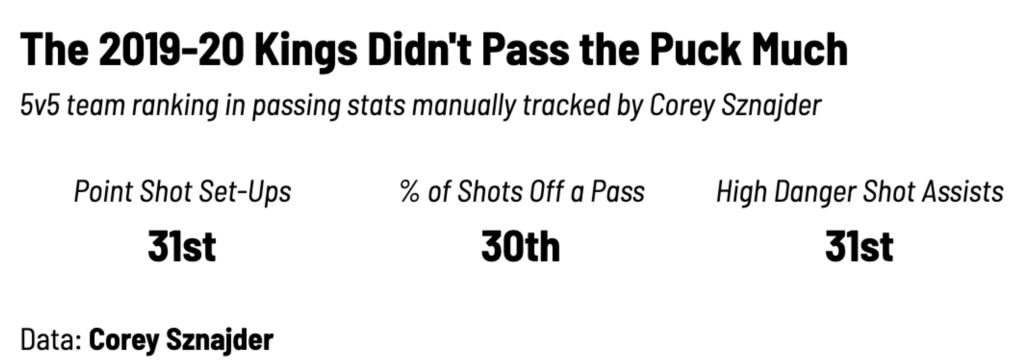
In spite of the Kings generating shots at the same rate Los Angeles produces smog, the pre-shot movement was terrible. This suggests that many of these chances came with the goalie square to the shooter or during net-mouth scrambles. The relevance of this to Toffoli is even clearer when one breaks down the centres he flanked during the 2019-20 season, and compare the on-ice rates of expected goals as opposed to goal-goals:
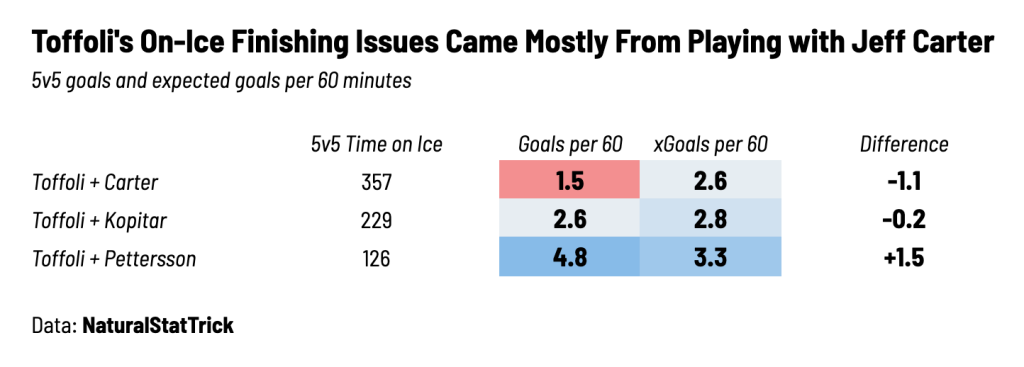
Toffoli spent most of last season with Jeff Carter, a forward who at this point in his career generates offence primarily by throwing absolutely everything on net. It’s no coincidence that the two of them dramatically underperformed relative to expectations together. When playing with a solid playmaker like Anze Kopitar (who registered a primary assist on seven of Toffoli’s nine goals after they started playing together), things got a lot better; when paired with the brilliant Elias Pettersson the Canucks’ top line exceeded expectations by a large margin. Here are the goals he scored with Vancouver last season:
You'll note how pre-shot passing almost always has the goalie moving. While Toffoli does have opportunities to show off accuracy (like the snipe against Arizona at 0:28), on most of these plays he does what he does best - finding a soft area and making no mistake while the goalie scrambles to back into position.
Toffoli the Hab
I had reservations about Toffoli as a free agent target for certain teams this offseason, namely the Montréal Canadiens. When Han suggested that the Habs look at Toffoli, I was maybe too clever by half based on the data from above:
i mean if the habs want to go from outshooting their opponents 35-25 and losing 3-2 to outshooting their opponents 45-25 and losing 3-2 they should definitely look into him https://t.co/96IPczgqzc
— JFresh (@JFreshHockey) October 2, 2020
My basis for this was the fact that the Habs, like the Kings, have had seemingly endemic finishing problems and similarly generated offence in a disjointed, one-and-done way that amounted to plenty of scoring chances but few goals. I envisioned a situation in which Toffoli would only exacerbate these issues and his abilities as a play-driver would reap even more diminishing returns. Exchanging Pettersson and J.T. Miller for whoever the Habs could muster in their middle-six wasn’t exactly encouraging either.
So far, it looks like I was dead wrong. Toffoli has nine goals and 13 points in 10 games, the leading scorer on a team that has - for now - dominated in terms of both out-chancing and out-scoring their opponents. That’s them in the top right corner:
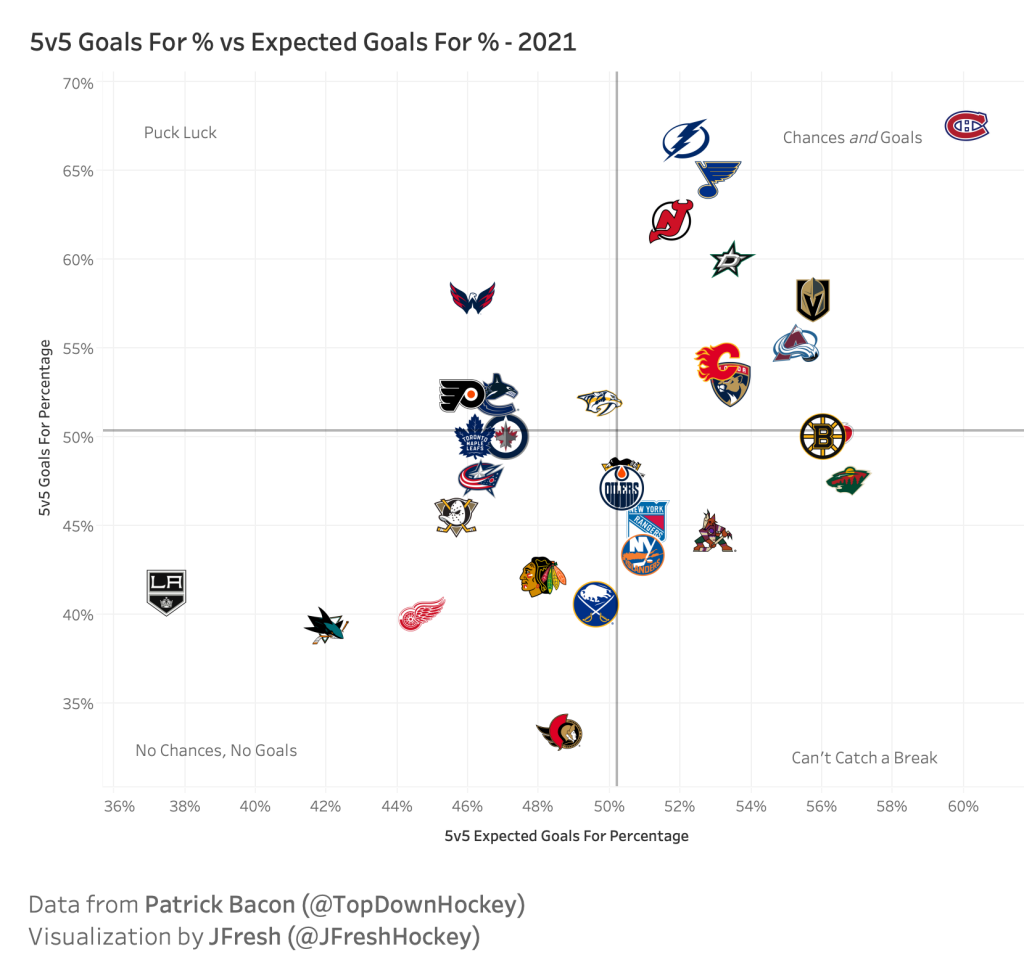
Despite playing on the team’s third line, Toffoli has been their biggest driver. It’s not just that he leads the team in goals and points, but his underlying numbers have been outrageous. When he’s been on the ice at even strength, the Canadiens have scored 80 percent of the goals and controlled 68 percent of the expected goals, both remarkable numbers. Even setting the goals aside, he does so many little things right that allow his teammates to maintain offensive zone possession. In this set of highlights from the Canadiens’ January 21st win over the Canucks, I want you to focus on two things: How the puck always seems to find him in the slot and how he makes simple continuation plays to support his linemates.
Toffoli’s teammates know that they have a triggerman in the slot and have done a great job of making short diagonal passes to set him up.
Zone time was a big issue for the Canadiens last season; according to SportLogiq, they ranked 24th in the league in offensive zone puck possession per game despite leading the NHL in shot attempts. But that hasn’t been an issue for the Toffoli - Jesperi Kotkaniemi - Joel Armia line because all of those players are adept at tracking down rebounds and keeping the play going. Toffoli has the ability and awareness to find pucks in traffic and get them back to the net while both of his linemates possess the speed and skill to win races to rebounds and get them back to the point or to the slot.
The biggest reason for Toffoli’s suddenly elevated goal totals is the shocking number of breakaways he's enjoyed. Despite his almost egregious lack of straight-line speed, in 10 games he’s taken five breakaways and scored on three of them. He has good instincts for when to sneak behind the defence and the Canadiens have players who can actually get him the puck when he does, so while I wouldn’t expect him to keep getting them at this pace it could yet another element of his game that’s unlocked by leaving the Kings.
I expected Toffoli’s on-ice and personal goalscoring problems to compound on a team like the Habs that shared many of his strengths and weaknesses. But so far the fit looks seamless and has actually gone away towards addressing their mutual struggles in the past few seasons.
You don’t have to be a stathead to recognize that Toffoli is most likely not going to score 50 goals in 56 games this season, and that expecting him to keep scoring on a quarter of the shots he takes will almost certainly lead to disappointment. But Habs fans should be excited. His elite impact on tilting the ice in his team’s favour has been a huge reason that the Canadiens have been one of the best teams in the league so far this season, and if he has truly left his on-ice finishing issues behind in Los Angeles he could legitimately be one of the most quietly effective wingers in the league moving forward.

